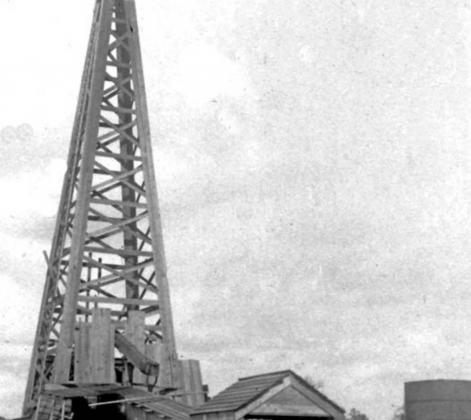It was in September of 1918 that Tom Dees was drilling near Desdemona, Texas and struck oil. His strike turned Desdemona into a boom town and suddenly oil wells were being drilled all over that area. Those in the know were able to invest $100 per share in Tom Dees’ Hog Creek Oil Company that could later be sold for $10,000. By late in 1919 the Wichita Falls, Ranger and Fort Worth Railroad went through the oil patch and was able to deliver oil to Dublin on its way to market. Though oil was not found in Dublin, we had the railroad transportation resources needed for refineries. (Wikipedia, Desdemona)
The Humble Oil and Refinery Company was making plans too. They were building a tank farm west of Dublin, close to Comyn. They said that it would employ three to four hundred men. The Katy Railroad would run a train to shuttle the men daily from Dublin to the tank farm as work was progressing. (Dublin Progress, April 4, 1919)
By September 1919, the headline read, “Big Oil Refinery Plant Will Be Built at Once.” The Pullman Oil & Refining Co. was making plans for a refinery here. The company said they needed 40 acres and a pipe line from Dublin to the oil field. They hoped the city could help to provide those. The plant would be of three thousand barrel capacity and construction would start in 60 days.”
(Dublin Progress, September 12, 1919)
The Dublin Oil and Refinery was also building their new refinery on their new property east of Dublin, across from the new Dublin Cemetery. A new 1000 foot siding was to be built next to the refinery by the MKT railroad. Contracts for oil had already been made. (Dublin Progress, October 31, 1919)
By May of 1920, thirty to forty men arrived in town to finish the plant of the Dublin Oil & Refinery. The newspaper pleaded that there was a need for places to stay for these men while they were finishing the plant.
(Dublin Progress, May 14, 1920)
A group of businessmen and capitalists from Nashville, Tennessee came to Dublin to see their new Dublin Oil & Refining Co. in operation and see the drilling that was taking place near here. (Dublin Progress, April 23, 1920)
While the Dublin Oil & Refining company was getting their refinery up and running, they were also drilling a water well to a depth of 400 feet east of town and hoped it would be operational in the next 30 days. (Dublin Progress, August 13, 1920)
In August, the Dublin Progress read, “Work on the Iowa Bankers Oil Company’s well, Dublin No. 1 is being pushed as fast as possible. Derrick is finished and machinery on the ground. Drillers are rigging up at a rapid pace and will likely be ready to spud in about the first of next week. Enthusiasm is running high.” (Dublin Progress, August 13, 1920)
The Dublin Oil Refinery had already made arrangements for crude oil to be shipped to Dublin. The company had contracted for a loading rack at Breckenridge with a capacity of ten cars daily. The Frisco railroad had been contacted for a special engine to haul the oil daily from the fields to the refinery here. (Dublin Progress, September 24, 1920)
Later in October, the headline was “Dublin Oil Refinery Delivering Products.” By that time the refinery was finally up and running and making gasoline. “The initial capacity of the plant operation is on the basis of one thousand barrels per day. It is expected that full capacity will be reached within the coming thirty days or so.” The reporter was able to try out the new gasoline from the plant and said his car ran fine with the new fuel.(Dublin Progress, October 8, 1920)
The publisher of the Dublin Progress wrote “For all we know these wells may last a lifetime.” That did not turn out to be the case. The Desdemona oil strike turned out to be a boom and bust. The peak years were from 1919 to 1922. By 1922 the boom was pretty much over.
Joe Duke became Texas’ youngest millionaire during the Desdemona oil boom. The money came and went easy. He was a pauper at the time of his death. (Wikipedia, Desdemona)
Though the Desdemona field had been over drilled and most of the available oil had been pumped out, new wells continued to be drilled toward Dublin. One headline said that “Much New Development Work Started in the New Dublin Field.” also “Trojan Well Repeats Flows Wednesday. Goes Over Top Crown Block Twice Wednesday Morning, Oct. 6.” (Dublin Progress, October 9, 1925)
A number of oil wells were drilled between Dublin and Desdemona. A few of the wells pumped some oil. None seemed to make people rich.

